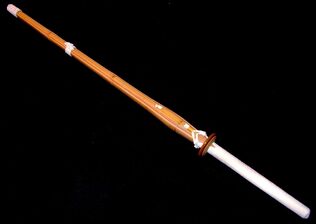Shinai (竹刀) are the weapons used for practice and competition in kendo. It represents a katana during keiko. Shinai are also used in other martial arts, but may be styled differently from kendo shinai and represented with different characters.
Shinai should not be confused with bokuto, or wooden swords used for kata practice.

Shinai
Construction[]
Parts[]
- Sakigawa
- Sakigomu
- Tsuru
- Nakayui
- Tsuba
- Tsubadome
- Tsuka
- Tsukagawa
- Take
- Chigiri
The sakigawa, nakayui, and tsukagawa all fall under the category of a shinai's leather parts. There are two kinds of leather to choose from. One is is gintuki leather, the other is toko leather. Toko is the cheaper kind and can normally be shortened (if so desired) by folding back the leather at the open end and making new holes for the leather thong that attaches to the tsuru. Gin tsukagawa are normally threaded at the tsuba end with a leather thong so they need to be cut at the closed tsukagashira end, and be sewn in a circle whilst turned inside out.[1] Gintuki leather generally stretches less and is less prone to ripping. English-speaking equipment suppliers often may not describe the leather as toko or gin. In such cases, gin is usually described as thicker leather or superlative in quality , while toko is described as thinner leather and relatively lower in quality (e.g. "Top Quality" vs. "High Quality/Performance").
Variations[]
Sizes[]
The names of shinai sizes based off of the Japanese system of measurements. A size 39 shinai is thus a 3 shaku 9 sun shinai.
Designs[]
Shinai also come in various styles, with differently shaped take, different types of bamboo, different shapes thicknesses in grip. There are smoked varieties, which have a distinctive color. There are even synthetic shinai too.

Kendo Gear - Types of Shinai and Shinai Maintenance - The Kendo Show
The three main shapes of shinai are as follows: dobari, normal, and chokuto/koto.
The three different materials most shinai are made of are keichiku, madake, and carbon fiber.
In this episode, host Andy Fisher introduces different types of Shinai, and offers advice on hot to choose one. Also he takes us through the process of Shinai maintenance.
When you choose your shinai, think of the length, weight, balance, type that fits your Kendo. Beyond that, you can decide on the quality of the tsukagawa, nakayui and other leather parts among other things. If you are new, don't sweat buying the super expensive fancy shinai. Shinai take a significant beating during practice, so for most people and most practices the marginal changes to the feel of a shinai usually aren't really needed until later. For the sake of cost and durability, a normal shinai will usually suffice.
Regulations[]
Shinai may be checked with a shinai gauge to verify the correct thickness.
Maintenance[]
Maintenance is important! Cracked/splintered take, loose tsuru, and loose nakayui all may cause the sakigawa to fall off during practice. This in turn may lead to accidents in which take slip through the mengane or splinters injure the body. Accidents like these have caused blindness and death. It is up to each kendōka to bear in mind the safety of all his or her fellows. Check each shinai before and after practice to ensure it is safe to use.

Shinai Maintenance
A less obvious part of shinai maintenance is moisture control. New shinai, including those shipped by plane and those stored or delivered to a dry location, often lose the moisture that prevent it from cracking. Oiling a shinai is a quick way of restoring moisture and avoiding breakage. There is a debate over which oils work well. However, whatever the case, be mindful that whatever goes into your shinai will come off onto your opponent's bōgu. One can help avoid bōgu stains by making sure shinai are thoroughly dried after oiling and by avoiding the use of wax to seal sanded-down splinters.[2] Alternatively, one can let a shinai adjust to the local humidity by storing it for a few months before use.
A good shinai will be strong and flexible, bending at the monouchi rather than at the tsuba when bent against the floor.[3]
See Also[]
- Shiaiyo
- Mokuju
